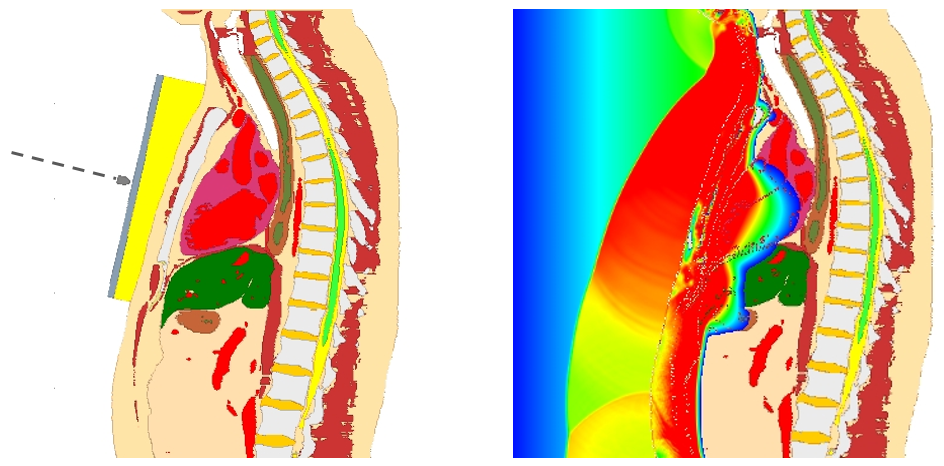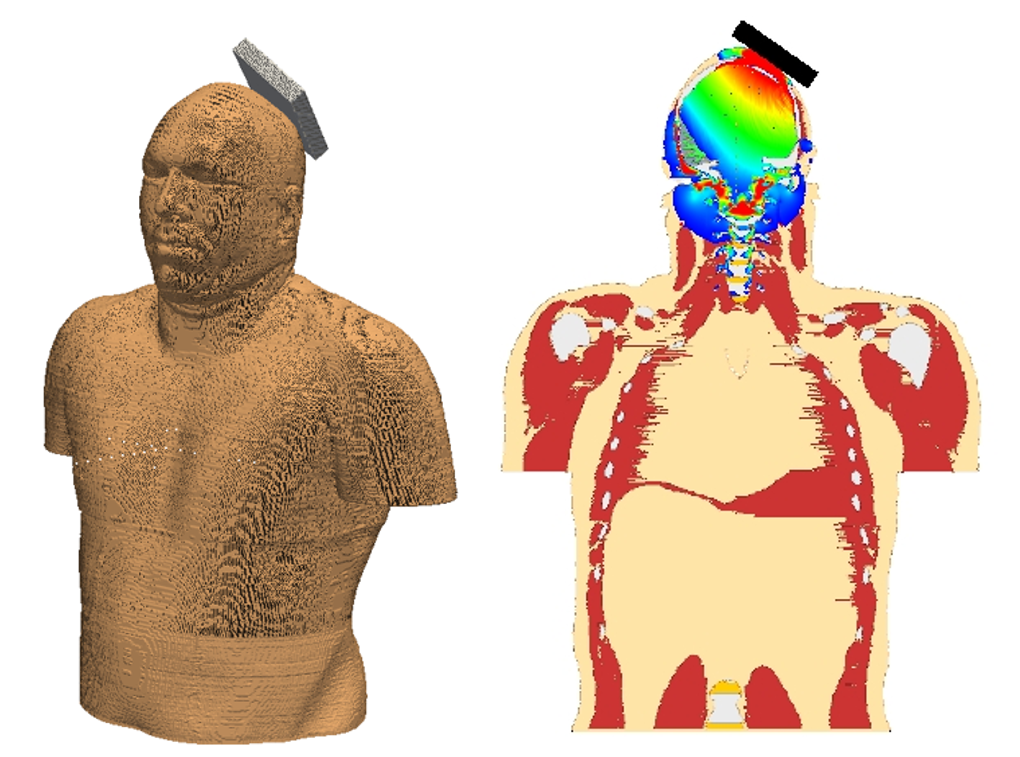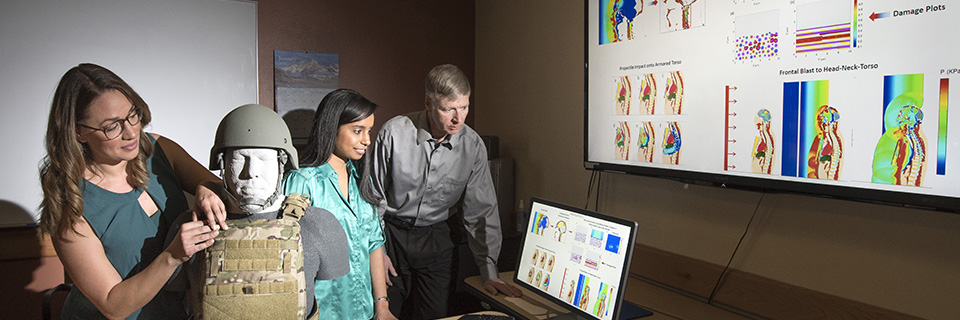Purpose
The Sandia Injury Biomechanics Laboratory analyzes injury due to blast, ballistics, and blunt trauma to help the nation protect the U.S. warfighter. Our contributions to the science of injury causation and prevention aim to significantly reduce the U.S. warfighter’s exposure to serious, severe, and fatal injuries.
Programs
Traumatic Brain Injury
Injury to the brain can occur from penetrating or blunt mechanical insults to the tissue, resulting in brain damage. Our research focuses on the mechanism of traumatic brain injury, secondary to blast exposure. We have demonstrated that significant overpressure from blast causes well-defined regions within the brain of deviatoric strain energy, implicated in the scientific literature as correlated with brain injury. Moreover, we have documented specific regions of isotropic tensile energy, suggestive of a cavitation injury mechanism.
Nonlethal Force
Several of our clients have the need to protect assets from adversarial actors. Our clients need to know if the effects they deliver are sufficient to neutralize the adversary, without causing undue human exposure to severe injury or fatality. Our expertise in human response has helped our clients understand which effects are lethal, and which effects are nonlethal, yet still incapacitating. Our biomechanical analysis has provided confidence to our clients, who know that their asset protection mission can be carried out in a humane and effective manner.
Injury Risk
To carry out its mission to the United States, Sandia National Laboratories and its collaborators embark on world-class, cutting-edge science, which inevitably can place humans in harm’s way. While exposure to injury risk is rarely unavoidable, the risk can be mitigated through careful and thorough engineering analysis. Our laboratory has a deep understanding of the human body’s response to mechanical stimuli from blast, ballistics, and blunt impact. This understanding has empowered our clients to take bold risks with science, not with personnel.
Capabilities
In service to our nation, the U.S. Warfighter can be exposed to many threats. Three significant threats are blast, ballistics, and blunt impact environments. Our ability to accurately model and understand these environments ultimately leads to a reduction in injury risk to our nation’s men and women in uniform.
Computational Blast Mechanics

We have the ability to model the effects of explosions on the head, neck, and torso with our high-fidelity human model and our state-of-the-art shock physics codes. The result: a detailed understanding of how the human body responds under blast environments.
Ballistics and Penetration Mechanics

We have the ability to model the effects of ballistics and other penetration mechanics scenarios to evaluate the efficacy of personal protective equipment (PPE). The result: a deeper understanding of how to protect life-critical organs from fast moving projectiles.
Blunt Impact Mechanics

We have the ability to model the effects of blunt impact, a nearly ubiquitous injury environment brought about through falls from height, vehicle rollovers, or impact from a flying object. The result: insight on how to better design helmets and other personal protective equipment.
Contributions
Peer Reviewed Publications
A-7. Terpsma R, Carlsen RW, Szalkowski R, Malave S, Fawzi AL, Franck C, Hovey C. Head impact modeling to support a rotational combat helmet drop test. Military medicine. 2021 Sep 11. Link to Terpsma 2021 and Download (3.3 MB).
A-6. Miller ST, Cooper CF, Elsbernd P, Kerwin J, Mejia-Alvarez R, Willis AM. Localizing Clinical Patterns of Blast Traumatic Brain Injury Through Computational Modeling and Simulation. Frontiers in Neurology. 2021;12. Link to Miller 2021 and Download (4.2 MB).
A-5. Haniff S, Taylor PA. In silico investigation of blast-induced intracranial fluid cavitation as it potentially leads to traumatic brain injury. Shock Waves. 2017;27:929-45. SAND2018-0037J. Unclassified Unlimited Release. Download (11.0 MB)
A-4. Taylor PA, Ludwigsen JS, Ford CC. Investigation of blast-induced traumatic brain injury. Brain injury. 2014 Jun 1;28(7):879-95. Download (4.1 MB)
A-3. Taylor PA, Ludwigsen JS, Vakhtin AA, Ford CC. Simulation and Clinical Assessment of Blast-Induced Traumatic Brain Injury. Neurotrauma Letter. 2013. Online only at internationalbrain.org
A-2. Vakhtin AA, Calhoun VD, Jung RE, Prestopnik JL, Taylor PA, Ford CC. Changes in intrinsic functional brain networks following blast-induced mild traumatic brain injury. Brain injury. 2013 Oct 1;27(11):1304-10. SAND2012-9584J. Unclassified Unlimited Release. Download (1.3 MB)
A-1. Taylor PA, Ford CC. Simulation of blast-induced early-time intracranial wave physics leading to traumatic brain injury. Journal of biomechanical engineering. 2009 Jun 1;131(6):061007. SAND2008-1188C. Unclassified Unlimited Release. Download (3.6 MB)
Conference Proceedings
B-3. Hovey C, Fawzi A, Szalkowski R, Malave S, Terpsma R, Franck C. Why the helmet military specification test should be revised to include a rotational component. Military Health System Research Symposium (MHSRS), accepted to session but online only due to COVID-19, August 24-27, 2020, Kissimmee, FL. SAND2020-3786A. Unclassified Unlimited Release. Download (52 KB)
B-2. Cooper CF, Taylor PA. Virtual Simulation of Blast, Behind-Armor Blunt Trauma, and Projectile Penetration Leading to Injury of Life-Critical Organs in the Human Torso. In ASME 2015 International Mechanical Engineering Congress and Exposition 2015 Nov 13 (pp. V003T03A061-V003T03A061). American Society of Mechanical Engineers. SAND2015-1470A. Unclassified Unlimited Release. Download (1.4 MB)
B-1. Haniff S, Taylor P, Brundage A, Burnett D, Cooper C, Gullerud A, Terpsma R. Virtual Simulation of the Effects of Intracranial Fluid Cavitation in Blast-Induced Traumatic Brain Injury. In ASME 2015 International Mechanical Engineering Congress and Exposition 2015 Nov 13 (pp. V003T03A062-V003T03A062). American Society of Mechanical Engineers. SAND2015-3372C. Unclassified Unlimited Release. Download (1.0 MB)
Reports
C-8. Terpsma, RJ, Hovey CB. Blunt Impact Brain Injury using Cellular Injury Criterion. SAND2020-11444. Unclassified Unlimited Release. Download (19.4 MB)
C-7. Taylor PA, Ludwigsen JS, Ford CC, Vakhtin AA. Verification and Validation of Simulation Framework for Analysis of Traumatic Brain Injury. SAND2018-7372. Unclassified Unlimited Release. Download (6.0 MB).
C-6. Taylor PA, Cooper CF, Vakhtin AA, Ford CC. Correlation of Injury Simulation with Clinical Assessment of Traumatic Brain Injury. SAND2018-7333. Unclassified Unlimited Release. Download (1.8 MB).
C-5. Taylor PA, Cooper CF. Simulation of blast and behind-armor blunt trauma to life-critical organs in the human body. Sandia HPC Annual Report 2016, p. 45. SAND2015-4086R. Unclassified Unlimited Release. Download (4.2 MB)
C-4. Taylor PA, Cooper CF, Burnett DJ. Wound ballistics modeling for blast loading, blunt force impact, and projectile penetration. SAND2015-7909. Unclassified Unlimited Release. Download (4.3 MB)
C-3. Taylor P, Cooper C. Simulation of blast and behind-armor blunt trauma to life-critical organs in the human torso. Sandia HPC Annual Report 2015, pp. 8-9. SAND2015-4086R. Unclassified Unlimited Release. Download (8.1 MB)
C-2. Taylor P, Ludwigsen J, Brundage A, Cooper C, Vakhtin A, Ford C. Investigation of blast-induced traumatic brain injury. Sandia HPC Annual Report 2013, p. 8. SAND2014-1247P. Unclassified Unlimited Release. Download (6.0 MB)
C-1. Taylor PA, Ford CC. Modeling and Simulation of Blast-Induced, Early-Time Intracranial Wave Physics Leading to Traumatic Brain Injury. SAND2008-0330. Unlimited Release. SAND2008-0330. Unclassified Unlimited Release. Download (1.2 MB)
Presentations
D-13. Hovey C, Terpsma R, Fawzi A, Szalkowski R, Malave S, Franck C. Investigation of incracranial strains and strain rates in a 3D human head model during military specification impact test. Military Health System Research Symposium (MHSRS), August 19, 2019, Kissimmee, FL. SAND2019-9601O. Unclassified Unlimited Release. Download (2.2 MB)
D-12. Cooper C, Dederman D, Haniff S, Hovey C, Ruggirello K, Terpsma R. Computational modeling of blast-induced cavitation bubble collapse. First international symposium on traumatic brain injury mechanisms and protection, April 11, 2019, Arlington, TX. SAND2019-4002C. Unclassified Unlimited Release. Download (10 MB)
D-11. Cooper C, Dederman D, Haniff S, Hovey C, Ruggirello K, Terpsma R. Geometric framework for finite element and finite volume analyses of blunt and blast insults to the Sandia head/neck model. DoD Computational Human Body Modeling Performer Workshop, February 5, 2019, McLean VA. SAND2019-0884A. Unclassified Unlimited Release. Download (7.5 MB)
D-10. Dederman D. Assessing armor performance using high fidelity blast, ballistics and blunt impact simulations. SAND2017-12793. Unclassified Unlimited Release. Download (760 KB)
D-9. Haniff S, Taylor P. Blast-Induced Intracranial Cavitation Leading to Damage of the Blood-Brain Barrier. American Society of Mechanical Engineers International Mechanical Engineering Congress and Exposition, November 5-8, 2017, Tampa FL. SAND2018-1294C. Unclassified Unlimited Release.
D-8. Cooper CF, Hovey CB, Taylor PA. In silico investigation of fluid cavitation as a potential damage mechanism in blast-induced traumatic brain injury. American Society of Mechanical Engineers International Mechanical Engineering Congress and Exposition, November 5-8, 2017, Tampa FL. SAND2017-12150C. Unclassified Unlimited Release. Download (4.8 MB)
D-7. Willis AM, Cooper C, Miller S, Mejia-Alvarez R, Tartis M, Welsh K, Wermer A, Hovey C, Masoomi F, Vidhate S, Ferguson K, Fuller I, Morgan R, Perl D, Taylor P. Building and validating a model of human blast traumatic brain injury: a hybrid computational and experimental approach. Military Health System Research Symposium, Air Force. SAND2017-09110C. Unclassified Unlimited Release. Download (10.9 MB)
D-6. Haniff S, Taylor P, Terpsma R, Cooper C. A computational study of intracranial cavitation in white matter axon fiber bundles as it relates to blast-induced traumatic brain injury. American Society of Mechanical Engineers International Mechanical Engineering Congress and Exposition, November 11-17, 2016, Phoenix AZ. SAND2017-1193C. Unclassified Unlimited Release. Download (10.6 MB)
D-5. Taylor PA, Cooper CF. Simulation of blast and behind-armor blunt trauma to life-critical organs in the human body. SAND2016-8689R. Unclassified Unlimited Release. Download (400 KB)
D-4. Haniff S, Taylor P, Brundage A, Burnett D, Cooper C, Gullerud A, Terpsma R. Virtual simulation of the effects of intracranial fluid cavitation in blast-induced traumatic brain injury. American Society of Mechanical Engineers International Mechanical Engineering Congress and Exposition, November 13-19, 2015, Houston TX. SAND2016-2111C. Unclassified Unlimited Release. Download ( 1.2 MB)
D-3. Cooper CF. Joining of human head-neck and torso models. SAND2015-6117PE. Unclassified Unlimited Release. Download (2.3 MB)
D-2. Cooper CF, Taylor PA. Virtual simulation of blast, behind-armor blunt trauma, and projectile penetration leading to injury of life-critical organs in the human torso. SAND2015-10049C. Unclassified Unlimited Release. Download (1.6 MB)
D-1. Cooper C, Taylor P. Human modeling and simulation for personal armor assessment. SAND2015-7468PE. Unclassified Unlimited Release. Download (1.6 MB)
Press Releases
E-2. Blast, impact simulations could lead to better understanding of injuries and body armor, Sandia Lab News Releases, January 23, 2018. Link to 2018 Sandia News or Download (249 KB)
E-1. Traumatic brain injury patients, supercomputer simulations studied to improve helmets, Sandia Lab News Releases, November 14, 2012. Link to 2012 Sandia News or Download (206 KB)
Contact
Chad Hovey
Technical Contact, Terminal Ballistics Technology
Department 5421
Sandia National Laboratories
PO Box 5800, Albuquerque, NM 87185-MS1160
505-844-2201


